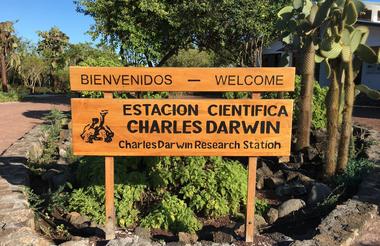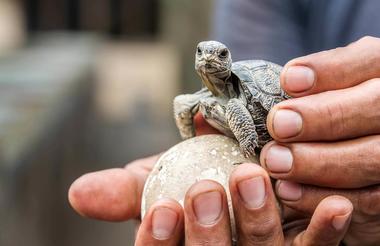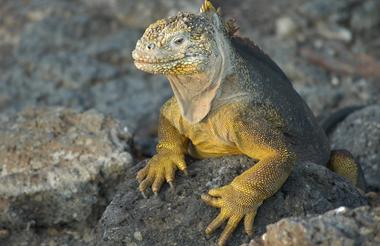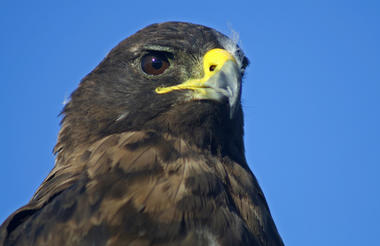Upon arriving to Baltra Airport, you will be transferred to Eco Galaxy II Catamaran at the bay. During the afternoon, you will visit Charles Darwin Station is located in the main port on Santa Cruz Island; we will take a private bus to the entrance of the breeding center where we will see tortoises and land iguanas in captivity. This center is the main breeding site on the islands. Animals that were in danger of extinction on the various islands are maintained in captivity. Thanks to the dedicated work of several institutions, some species are being saved. Here lived Lonesome George, the famous last survivor of the giant tortoise species found on Pinta Island.
Full itinerary map here: http://bit.ly/ecogalaxy-2020-6-days-b



MORENO POINT: In the morning, we will disembark at Moreno Point which is located near Elizabeth Bay on the west coast of Isabela Island. The plethora of birds seen during a dinghy ride along the striking rocky shores or a hike along a path through lava rock leading to tide pools and mangroves, create a birdwatcher’s delight. In the tide pools, green sea turtles or white-tip sharks can be spotted.
ELIZABETH BAY: This is one of the island’s breeding sites for penguins. Located on the west coast of Isabela, Elizabeth Point is a marine visitor site. Visit Red Mangrove Cove: Brown pelicans, flightless cormorants, spotted eagle rays, golden rays and sea lions are often seen.



Breakfast
Lunch
Dinner
TAGUS COVE: First, you will visit Tagus Cove in Isabela Island, for a hike to the top of a cliff to view the volcanic landscapes of Darwin Volcano and Darwin Lake
URBINA BAY: this place is located at the base of Alcedo Volcano between Elizabeth Bay and Tagus Cove. Wet landing. Trail length is around 3.20 Km; during this walk, we can observe land iguanas, hawks, and tortoises. It is also possible to see red and blue lobsters. Dinner.



Breakfast
Lunch
Dinner
FERNANDINA ISLAND – ESPINOZA POINT: Fernandina is the third biggest island in the Galapagos and has only one visiting site: Espinoza Point, famous for the large colonies of marine iguanas and the home of the flightless cormorant, the Galapagos penguin, snakes, and more. From Espinoza Point, we can admire the beauty of Fernandina Island and its volcano which last erupted in May of 2005. Fernandina is the only island that doesn’t have mammals and the open areas are extremely fragile. From January to June, the nesting period of the marine iguana, we take great care when walking. Return to EcoGalaxy. Lunch.
ISABELA ISLAND: VICENTE ROCA POINT: is comprised of two separate coves, this site is a large bay with spectacular sea life. Keep an eye out for seahorses, sea turtles, and the strange yet fascinating Mola-mola (sunfish). Dinner.



Breakfast
Lunch
Dinner
EGAS PORT: Here we find a beautiful black sand beach; to the south of the beach is the Pan de Azucar Volcano, whose volcanic deposits have contributed to the formation of the black sand beach. The crater of this volcano contains a saltwater lake that dries up during hot weather. Between 1928 and 1930, explorations to develop a salt mine were carried out, but it was decided that a mine was not feasible. The workers’ use of endemic woods also damaged the environment and the development was scrapped. Descent to the salt mine is not allowed. Lunch.
RABIDA ISLAND:
The visitor site, located on the east coast of Rabida Island, consists of a red sand beach, a coastal lagoon behind the beach, and a loop trail of approximately 1.1 km length.
The red color of the rocks and sand on the beach is due to the interaction of the very porous volcanic material with environmental factors. Rain, salt water and the sea breeze, act as oxidizing agents, creating the red color. The scenery, arid zone vegetation and the presence of native and endemic species, add to the beauty of this island. Dinner.



BLACK TURTLE COVE: After lunch our first visit is to Black Turtle Cove which is situated in the northern region of Santa Cruz. This bay is surrounded by mangroves and is accessible only by dinghy only. The shallow cove is a safe refuge for marine life. Black-tip reef sharks, marine turtles, and a variety of rays are often spotted here. Transfer to the airport.



Breakfast








